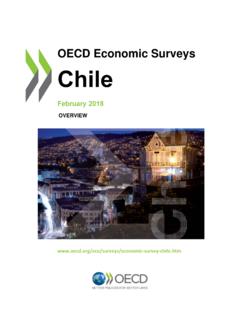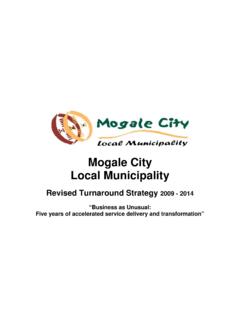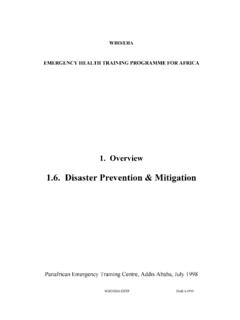Transcription of 5. Mauritius: An Economic Success Story
1 1 5. mauritius : An Economic Success Story Ali Zafar January 2011 There is no miracle. It is due simply to hard work, discipline, and will. Sir Anerood Jugnauth, President of mauritius mauritius is paradise..It is beautiful here and we all work together. M. Rambonee, Mauritian taxi driver Ali Zafar is a macroeconmist in the World Bank Group.. This paper is part of the Africa Success Stories project, a World Bank research initiative being carried out by the Office of the Chief Economist, Africa Region. 2 Contents Abstract Acknowledgments Introduction: Anatomy of the Mauritian Miracle The Growth Story A well-managed Economic regime A very successful Economic trajectory Favorable international comparisons The role of total factor productivity Structural transformation Improvement in human development indicators Macroeconomic Management Prudent, proactive fiscal policy Monetary policy as an anchor for Economic growth Effective response to Economic shocks Dynamic Institutions and Adaptability to Change The importance of forging consensus The nexus between the public and private sectors A Tale of Three Sectors: Sugar, EPZs, and Tourism The sugar sector Import substitution industrialization and restrictive trade policies following the colonial period The rise of EPZs in the 1970s and 1980s Post-EPZ Economic drivers.
2 Tourism, business process outsourcing, and financial services Business Climate and Investment Business climate improvement in recent years The role of foreign direct investment The Economic Future of mauritius References 3 Abstract In spite of its small Economic size, low endowment of natural resources, and remoteness from world markets, mauritius has transformed itself from a poor sugar economy into one of the most successful economies in Africa in recent decades, largely through reliance on trade-led development. Real GDP growth averaged more than 5 percent between 1970 and 2009, while GDP per capita has increased more than tenfold over the same period. Though its Economic Success has been the subject of considerable debate, several key factors were central in bringing about the Mauritian miracle: good macroeconomic policies, particularly fiscal prudence and a competitive exchange rate policy; strong public sector and private sector institutions, with exceptionally productive interaction between the two; a strong, pro-trade orientation and a liberal trade regime; and use of its ethnic diversity to forge a consensus between the different groups.
3 In parallel to its Economic growth, mauritius has achieved significant improvements in key human development indicators. Acknowledgments The author benefited from the guidance and the insights of many Mauritian policy makers, specifically: Raj Makoond (Director, Joint Economic Council), Ali Mansoor (Financial Secretary, Ministry of Finance and Economic Development), Ada Chellapermal (Director, Financial Policy, Ministry of Finance and Economic Development), Mahmood Cheeroo (Secretary General, mauritius Chamber of Commerce and Industry), Patrice Legris (Chief Executive Officer, Association des H teliers et Restaurateurs de l Ile Maurice [AHRIM]), Sunil Boodhoo (Deputy Director, International Trade Division), Danielle Wong (Director, mauritius Export Association), Amedee Darga (Chairman, Enterprise mauritius ), Ahmed Parkar (Chief Executive Director, Starknitwear Group and Former Chairman, MEXA).
4 From the World Bank, Rojid Sawkut (Economist) participated in several discussions and offered guidance at each stage of the paper. Constantine Chikosi (Country Manager) and Fabiano Bastos (Economist) also offered valuable and insightful commentary during the drafting of the paper. Mariella Bergue offered kind assistance with the scheduling of meetings and discussions. 4 Introduction: Anatomy of the Mauritian Miracle Defying the predictions of James Meade, a Nobel Prize recipient in economics who famously predicted a dismal future for mauritius in 1961 due to its vulnerabilities to weather and price shocks and lack of job opportunities outside the sugar sector, the small island nation in the Indian Ocean of approximately million people has transformed itself from a poor sugar economy into a country with one of the highest per capita incomes among African combination of political stability, strong institutional framework, low level of corruption, and favorable regulatory environment has helped lay the foundation for Economic growth, while its open trade policies have been key in sustaining growth.
5 The government functions as a parliamentary democracy, and the country has an efficient administration that is both technically competent and adaptive to changing global Economic circumstances. mauritius financial sector sufficiently well developed, that the country has begun to position itself as a platform for investment linking East Africa with India and China. Headline figures related to mauritius Economic performance are impressive. Real GDP growth has averaged more than 5 percent since 1970 and real annual growth in per capita income, likewise, has been strong. GDP per capita increased more than tenfold between 1970 and [2010], from less than $500 to more than $6,000. Imports and exports have boomed; together, they have reached more than 100 percent of GDP during the late 1990s and 2000s. At the same time, efforts at Economic diversification have been successful, allowing the country to move from sugar to textiles to a broader service economy.
6 mauritius reliance on trade-led development has helped the country achieve respectable levels of export performance. Along the way, measures of human development have improved substantially. Despite being a small island economy vulnerable to exogenous shocks, mauritius has been able to craft a strong growth-oriented developmental path. Natural disasters and terms of trade shocks have never prevented the economy from having a strong and regular growth. Constrained at inception by a mono-crop sugar economy, low amounts of arable land, and a high population growth rate, mauritius 1 Careful empirical work by Subramanian (2003) shows how initial conditions in mauritius especially the level of income, geography, and commodity dependence have hurt long-term growth, while there has been some mitigation due to favorable demography and high levels of human capital.
7 For example, mauritius is disadvantaged by being at least 25 30 percent more distant from world markets than the typical African country. Statistical analysis, however, shows that on balance, the disadvantages outweigh the advantages: initial conditions have slowed growth by about 1 percentage point per year relative to the average African country and by nearly 2 percentage points relative to the fast-growing developing economies of East Asia. 5 has emerged as a regional entrepot and tourism destination as well as the top-ranked African country in the World Bank s Doing Business (in 2009, it ranked xx out of xxx countries). Though a variety of explanations have been developed to explain mauritius growth performance, there is no doubt that the country s focus on international trade has been a critical element of that mauritius preferential access to trading partners, particularly the European Union (EU), in the sugar, textile, and clothing sectors resulted in subsidies for the export sector and provided important foreign exchange for the economy.
8 Preferential trading deals accounted a strong growth in mauritius 's total exports between the 1970s and the 1990s. Though imports tariffs in mauritius were kept high , they have never been high enough to interfere with the overall trade regime. For example. the average tariff for manufacturing was in 1980, but it did fall to in 1994 (Wignaraja and O Neil, 1999). Simultaneously, mauritius pursued a very liberal investment regime and used incentives to attract foreign direct investment (FDI). mauritius also offset the burdens on its exporters with tariff-free access for productive inputs and with tax incentive subsidies, and relaxed labor market regulations, in the export sector. Furthermore, it has used export processing zones (EPZs) to export key manufacturing goods, mostly apparel and textiles. mauritius overall trade and investment policy has been based on a managed embrace of globalization and cultivation of market access.
9 Aside from its trade and investment policy, mauritius has benefited from prudent fiscal, exchange rate, and monetary policy, the latter of which has also been beneficial to export performance. To compensate for the myriad disadvantages of limited scale, mauritius has also developed a plethora of strong institutions and good governance. Additionally, the public and private sectors maintain a vibrant partnership that manifests itself in a range of areas. Finally, mauritius has always displayed receptivity to new ideas and adaptability. At various points in its history, mauritius has used intervention, subsidization, and targeting to adapt to the shifting Economic circumstances by crafting imaginative public policy to adapt to shocks. Though mauritius benefited from the sugar protocols, the government also recognized early on the advantages of diversification. As such, it relied heavily on EPZs but ensured that there was no antiexport bias.
10 mauritius also has proven very adept at embracing new sectors, particularly light manufacturing, offshore banking and financial services, and and service-related information and communication 2 See Sachs-Warner [1995, 1997], Meade (1961), Rodrik [1999], Romer [1993], and Subramanian and Roy[2001], among others. 6 technology (ICT). It has adapted and transformed its ethnic pluralism into a tangible Economic It has forged a vibrant democracy with competing parties, a strong electoral system, and an open In sum, mauritius impressive Economic performance has not been an accident, but rather the result of careful planning and policies. During and in the aftermath of the biggest exogenous shocks to its economy in recent times the phasing out of the Multifibre Arrangement governing textiles, significant reductions in EU sugar protocol prices, the 2008 food and fuel crisis, and the 2008 09 global financial crisis mauritius s economy has displayed strong resilience.

















